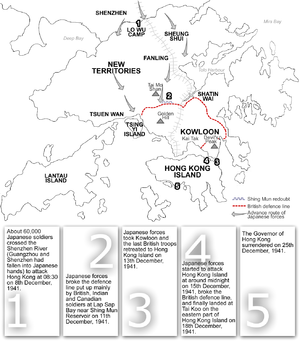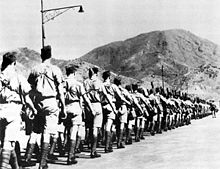Battle of Hong Kong
| date | December 8-25, 1941 (local time) |
|---|---|
| place | Hong Kong |
| output | Japanese victory |
| Parties to the conflict | |
|---|---|
| Commander | |
| Troop strength | |
| approx. 14,000 men | about 50,000 men |
| losses | |
|
at least 3,400 dead and wounded |
at least 2,750 dead and wounded |
1941
Thailand - Malay Peninsula - Pearl Harbor - Hong Kong - Philippines - Guam - Wake - Force Z - Borneo
1942
Burma - Rabaul - Singapore - Sumatra - Timor - Australia - Java - Salamaua - Lae - Indian Ocean - Port Moresby - Coral Sea - Midway - North America - Buna-Gona - Kokoda-Track
The Battle of Hong Kong was one of the first battles of the Pacific War and took place immediately after the war began in December 1941. The outnumbered Japanese troops captured the British colony within 18 days.
background
The conquest of Hong Kong formed part of the operations of the Japanese armed forces at the beginning of the Pacific War , with which the Japanese Empire wanted to exclude the extra-Asian colonial powers from East Asia and realize its hegemonic ambitions in this region of the world. The background was formed by the Japanese campaigns of conquest in the Republic of China that had been waged since the early 1930s ( Manchuria crisis ) , which had escalated into the Second Sino-Japanese War since the summer of 1937 . Driven by the belief in a "sacred mission" for Japan in Asia, the country tried to subjugate the far more populous but underdeveloped China to its goals. The "China Incident" ( Japanese支那 事變 ), which was largely triggered by the military , has been a focal point of international politics since 1937 and led directly to the Pacific War, which was part of the global Second World War .
Hong Kong, protected by its status as a British crown colony , was one of the few lifelines to the outside world that China still had after the Japanese occupation of most of the Chinese foreign trade ports. In 1940 around 40 percent of Chinese imports of war material still went through Hong Kong. In October 1938, Japanese troops landed in Daya Bay , around 50 kilometers northeast of Hong Kong, and occupied the neighboring canton . In the period that followed, border incidents continued and hundreds of thousands of Chinese civilians fled to the relative safety of Hong Kong. In January 1939, the Japanese also occupied the island of Hainan , around 300 kilometers southwest of Hong Kong, and planned to build a larger naval base there. In the British military leadership, fears grew that Japan would use the war that broke out in Europe in September 1939 between Great Britain and France on the one hand and Germany on the other to wrest Hong Kong from the British.
The regular garrison of Hong Kong in the late 1930s consisted of four infantry battalions (two British and two Indian ), five coastal artillery batteries, two field artillery regiments , two companies of pioneers and one intelligence company. In addition, there was a local militia, the Hong Kong Volunteer Defense Force , with around 1,700 men. These troops had been under the command of Canadian-born British Major General Arthur Grasset since November 1938 . After the fall of France in the summer of 1940, the British leadership under Winston Churchill decided to treat Hong Kong merely as an outpost that should be defended, but impossible to hold in the event of a war against Japan. Grasset disagreed with this view and found support from Air Chief Marshal Robert Brooke-Popham , Commander in Chief of the British Far East Command from November 1940, and Rear Admiral Tom Spencer Vaughan Phillips , Deputy Chief of the British Admiralty. The gin drinkers line in the New Territories was strengthened and air raid shelters and coastal fortifications on the north coast of the island were built.
At the end of January 1941, Japan unilaterally announced a Franco-Japanese agreement on the joint defense of French Indochina , to which Great Britain and the USA responded with economic sanctions. The situation worsened in the course of the year and in the summer of 1941 it was foreseeable that a war would break out.
Planning and forces employed by the Japanese
On November 6, 1941, the Japanese Army and Navy Headquarters ordered the Commander-in-Chief of the China Expeditionary Army , Hata Shunroku , to plan an operation to capture Hong Kong. This should be carried out by around 50,000 men of the Japanese 23rd Army under Sakai Takashi with the 38th Division as the main force and with support from the Navy and Air Force. The operation was to begin on the first day of the war, once news of the successful invasion of the Malay Peninsula came on . The 38th Division was to cross the border at Shenzhen and occupy Mount Tai Mo Shan . A marine landing department was supposed to operate around Tsing Yi Island . After the complete capture of the Kowloon Peninsula , the 38th Division should land on the north side of Hong Kong Island . A mock attack was to be carried out on the south side to confuse the defenders.
Japanese ground forces to be used were (in addition to the 38th Division under Sano Tadayoshi ):
- 1 reinforced infantry regiment
- 2 independent anti-tank departments
- 1 independent mountain artillery regiment
- 1 heavy field artillery regiment
- 1 heavy field artillery division
- 1 mortar department
- 3 independent engineer regiments, including 1 with special equipment for landing operations
In addition, there were siege forces:
- 1 artillery headquarters
- 1 heavy artillery regiment with Type 45 24 cm howitzers
- 1 independent heavy artillery division with 15 cm cannons
- 1 independent mortar department
as well as logistic units.
The Army Aviation Forces provided:
- 1 squadron each of reconnaissance and fighter aircraft
- 1 light bomber regiment
- 1 aerodrome department
The Navy was involved with the main forces of the 2nd China Expedition Fleet.
The Japanese ground troops began their camouflaged march from the Canton area to the border with the Northern Territories at Shenchuanhsu on December 1.
Forces of the Hong Kong Defenders
The British forces in the defense of Hong Kong were commanded by Major General Christopher Maltby , who had replaced Grasset in the summer of 1941. Grasset had traveled back to England via Canada and played a role in brokering the Canadian government's offer to reinforce the Hong Kong garrison with two Canadian battalions . The so-called "C" Force reached Hong Kong on November 16, 1941. This means that the following units were in Hong Kong at the time the war broke out:
- 1st Middlesex
- 2nd Royal Scots
- 5 / 7th Rajputs
- 2 / 14th Punjabis
- Royal Rifles of Canada
- Winnipeg Grenadiers
- Hong Kong Volunteer Defense Corps
- Detachment, Royal Artillery
- Detachment, Hong Kong and Singapore Royal Artillery
- various support units
These troops with a strength of around 14,000 men were divided after the arrival of the Canadians into the Mainland Brigade under Brigadier Cedric Wallis and the Iceland Brigade under Brigadier John K. Lawson .
course
On December 8th at 4:00 am local time, the 23rd Army ordered an attack. The operation began with air strikes on Kai Tak Airport , where some British planes were devastated. The ground forces, with little resistance, reached Yuen Long and Tai Po on the first day of Operation . The following day, the Army Command ordered preparations to be made for the attack on the British main line of defense, which was estimated to be about a week. The main attack was to be on the high altitude area southwest of the Shing Mun reservoir. After reconnaissance attempts had exposed the weakness of the British defense, the line was broken in several places on December 11th. The British began evacuating the mainland. On the same day the island of Tsing Yi was conquered, the line Kowloon City - Kai Tak Airport - Tseng Lan Shu reached the next day . Until December 14th, the Kowloon Peninsula was firmly in Japanese hands. The surprisingly rapid advance of the Japanese led them to believe that they could carry out the attack on the island immediately after the operations on the mainland. Defenders should not be given time to regroup. Nevertheless, it took several days to get the heavy equipment and the landing craft.

On the night of December 19, the Japanese Navy carried out its mock attack in the south of the island, while at the same time the siege artillery covered the north coast with their fire. At around 9:00 p.m., the troops of the 38th Division landed and began their operations on the east side of the island. The British, who had now regrouped their forces into an East and a West Brigade, lost the headquarters of the East Brigade on December 19, of which Lawson fell. The defenders retreated south onto Mount Nicholson . The heavy resistance and the difficult terrain led to some confusion among the Japanese units that day. On December 20, the Japanese artillery was drawn to the island and the situation stabilized for the Japanese. They turned their attention now to the western half of the island and finally got the remaining defenders to surrender on December 25th , which was carried out by Governor Mark Aitchison Young at the Peninsula Hotel in Kowloon. An evacuation by sea was no longer possible after the destruction of Force Z by Japanese aircraft on December 10th.
Losses and consequences

The Japanese side stated their losses in a publication from the 1950s with 675 dead and 2079 wounded. The British side reported their own losses as 2,113 dead and at least 1,332 wounded, thousands more were taken prisoner of war. In the course of the fighting there were rape and killing of civilians and nurses of the British Army, and the killing of prisoners of war and the wounded of the defenders.
For the British colony began an occupation of over three and a half years , which ended in August 1945. As in other areas of China, there was an active resistance movement in Hong Kong that operated from underground.
Web links
- Hong Kong on canadiansoldiers.com
Individual evidence
- ^ Benjamin Lai: Hong Kong 1941–45: First Strike in the Pacific War , Osprey, 2014, p. 6.
- ^ Brereton Greenhous: "C" Force to Hong Kong: A Canadian Catastrophe, 1941-1945. Dundurn, 1997, p. 6.
- ↑ Greenhous: "C" Force to Hong Kong. P. 7.
- ↑ Greenhous: "C" Force to Hong Kong. P. 10.
- ↑ Tony Banham: Not the Slightest Chance: The Defense of Hong Kong, 1941. University of British Columbia Press, 2003, p. 6.
- ↑ Greenhous: "C" Force to Hong Kong. P. 11.
- ↑ Banham: Not the Slightest Chance. P. 9.
- ↑ This and the following information from: Army Operations in China, December 1941 – December 1943 (= Japanese Monograph, No. 71), prepared by Headquarters, USAFFE and Eighth US Army (Rear), 1956 (PDF; 12.4 MB), P. 29, table 1.
- ^ Army Operations in China, December 1941 – December 1943 (= Japanese Monograph, No. 71), prepared by Headquarters, USAFFE and Eighth US Army (Rear), 1956 (PDF; 12.4 MB), p. 38.
- ↑ Banham: Not the Slightest Chance. P. 11 f.
- ^ Army Operations in China, December 1941 – December 1943 (= Japanese Monograph, No. 71), prepared by Headquarters, USAFFE and Eighth US Army (Rear), 1956 (PDF; 12.4 MB), p. 48.
- ↑ James C. Bradford: International Encyclopedia of Military History. Routledge, 2004, p. 615.



